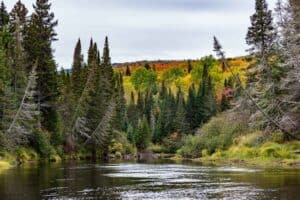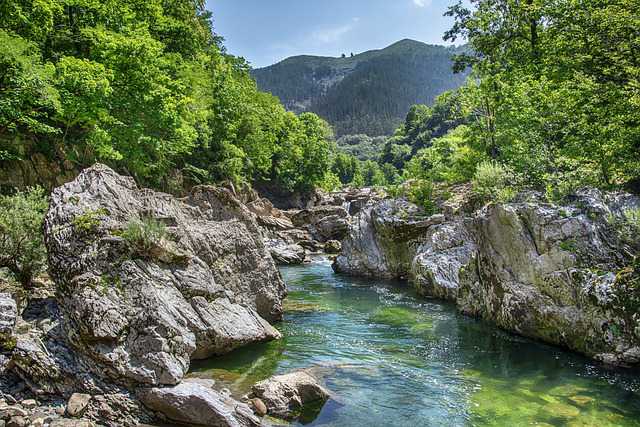Natural vegetation is a crucial part of nature, playing a role in keeping things in balance. Importance of natural vegetation has a great value, as it regulates water, carbon, and nitrogen cycles.
Using sunlight, plants create biomass, which is the foundation for all the food chains in nature. Plants also impact the balance of energy on the Earth’s surface and in the air around it, helping to even out extreme local weather conditions.
Besides these things, natural vegetation release oxygen and store carbon. Over time, they help in the development of soil, making it more productive. Plants are homes and food for wildlife, and they give us things we directly use, like wood, and indirect benefits, such as protecting water sources.

Importance of Natural Vegetation
Plants are vital for the overall health of the planet, as each species plays a unique role in the ecosystem, ensuring its resilience to changes. When we conserve natural vegetation, we preserve habitats that countless organisms rely on for survival.
Conserving natural vegetation is crucial for many reasons, these ecosystems support a wide variety of plants and animals, creating a balanced and diverse environment.
Here is how natural vegetation is importance for all living on the earth.
The Ecological Importance of Natural Vegetation
Natural vegetation plays a fundamental role in maintaining ecological balance, fostering biodiversity, and providing essential ecosystem services that contribute to the overall health of the planet.
Ecological Role of Natural Vegetation
The ecological role of natural vegetation refers to the functions and contributions of plant life within ecosystems. This includes processes such as nutrient cycling, soil stabilization, and the regulation of water flow.
Natural vegetation acts as the foundation of ecosystems, influencing the physical and chemical properties of the environment. It contributes to the health and stability of ecosystems by providing habitats for various organisms, influencing climate patterns, and participating in nutrient cycles.
Biodiversity and Natural Vegetation
Biodiversity in the context of natural vegetation refers to the variety of plant and animal species present in a particular habitat. It encompasses genetic diversity, species diversity, and ecosystem diversity.
Natural vegetation supports a rich diversity of life, from microorganisms to large mammals. Biodiversity is crucial for ecosystem resilience, as each species plays a unique role in maintaining ecosystem functions. The loss of natural vegetation can lead to a decline in biodiversity, impacting the overall health of the environment.
Ecosystem Services Provided by Natural Vegetation
Ecosystem services are the benefits that humans and other organisms derive from ecosystems. Natural vegetation contributes to various ecosystem services, including provisioning, regulating, supporting, and cultural services.
Ecosystem services provided by natural vegetation include clean air and water, pollination of crops, climate regulation, and the provision of raw materials. These services are essential for human well-being and the functioning of ecosystems.
Environmental Benefits of Natural Vegetation
Natural vegetation offers a myriad of environmental benefits, from mitigating climate change to sustaining life by producing oxygen and sequestering carbon.
Carbon Sequestration by Natural Vegetation
Carbon sequestration refers to the capture and storage of carbon dioxide from the atmosphere. Natural vegetation, especially forests, plays a critical role in sequestering carbon through the process of photosynthesis.
Trees and plants absorb carbon dioxide during photosynthesis and store carbon in their biomass. This helps mitigate the greenhouse effect, reducing the impact of climate change by regulating atmospheric carbon levels.
Oxygen Production from Natural Vegetation
Oxygen production is the release of oxygen into the atmosphere as a byproduct of photosynthesis, a process carried out by plants and certain microorganisms.
Natural vegetation, particularly forests and phytoplankton in aquatic ecosystems, is a primary source of oxygen production. This oxygen is vital for the survival of aerobic organisms, including humans.
Climate Change Mitigation and Natural Vegetation
Climate change mitigation involves actions that reduce or prevent the emission of greenhouse gases and enhance the capacity of ecosystems to absorb and store carbon.
Natural vegetation plays a crucial role in mitigating climate change by absorbing carbon dioxide, regulating temperatures, and preserving biodiversity. Conserving and restoring natural vegetation are essential strategies for addressing climate change.
Also Read: Human Role in Biodiversity Conservation
Economic Significance of Natural Vegetation
Natural vegetation holds economic value through sustainable resource use, agriculture, forestry, and contributions to local economies.
Economic Value of Natural Vegetation
The economic value of natural vegetation refers to the direct and indirect contributions of plant ecosystems to local and global economies.
Natural vegetation provides resources such as timber, non-timber forest products, and pharmaceuticals. Additionally, ecosystems like wetlands and mangroves contribute to fisheries, tourism, and other economic activities.
Sustainable Resource Use from Natural Vegetation
Sustainable resource use involves harvesting natural resources in a manner that allows ecosystems to regenerate and maintain their ecological functions.
Using resources sustainably from natural vegetation includes practices such as selective logging, agroforestry, and the cultivation of non-timber forest products. These practices ensure the long-term viability of natural resources.
Role in Agriculture and Forestry
The role of natural vegetation in agriculture and forestry encompasses the influence of plant ecosystems on food production, soil fertility, and forestry practices.
Natural vegetation provides essential services to agriculture, such as pollination, pest control, and soil fertility. Forests contribute to timber production, watershed protection, and the preservation of biodiversity.
Cultural and Aesthetic Value
Natural vegetation holds cultural significance, aesthetic beauty, and indigenous knowledge that contribute to human well-being and identity.
Cultural Significance of Natural Vegetation
Cultural significance refers to the importance of natural vegetation in shaping the identity, beliefs, and practices of different human cultures.
Many cultures around the world have spiritual, religious, and symbolic connections to natural landscapes. Trees, plants, and ecosystems are often integral to cultural practices and traditions.
Aesthetic Beauty of Natural Vegetation
Aesthetic beauty in natural vegetation pertains to the visual appeal and artistic inspiration derived from the diverse and intricate forms found in plant ecosystems.
Natural vegetation, from lush forests to arid deserts, provides breathtaking scenery that inspires artists, poets, and nature enthusiasts. The aesthetic beauty of landscapes contributes to the well-being of individuals and societies.
Indigenous Knowledge and Natural Vegetation
Indigenous knowledge refers to the traditional ecological knowledge and practices developed by indigenous communities regarding natural vegetation.
Explanation: Indigenous communities often possess profound knowledge about the uses of plants for medicine, food, and materials. Preserving and respecting indigenous knowledge contributes to sustainable resource management.
Wildlife Habitat
Natural vegetation serves as critical habitat for wildlife, supporting diverse fauna and playing a key role in the conservation of natural habitats.
Natural Vegetation and Wildlife Habitat
Natural vegetation as wildlife habitat refers to the ecosystems that provide food, shelter, and breeding grounds for a wide variety of animal species.
Different types of natural vegetation, such as forests, grasslands, and wetlands, offer unique habitats for various wildlife species. These habitats are essential for the survival and reproduction of fauna.
Importance of Natural Vegetation for Fauna
The importance of natural vegetation for fauna underscores the reliance of animal species on specific plant ecosystems for their survival.
Animals depend on natural vegetation for food, shelter, and breeding sites. The composition and structure of plant communities influence the diversity and abundance of wildlife in an ecosystem.
Conservation of Natural Habitats for Wildlife
Conservation of natural habitats for wildlife involves efforts to protect and restore ecosystems that provide crucial habitats for a variety of animal species.
Conservation initiatives focus on preserving and restoring natural vegetation to ensure the continuity of wildlife populations. This includes creating wildlife corridors, establishing protected areas, and addressing habitat fragmentation.
Educational Aspects of Natural Vegetation
Natural vegetation serves as a valuable educational resource, providing opportunities for studying ecology, environmental science, and fostering an understanding of the natural world.
Educational Value of Studying Natural Vegetation
The educational value of studying natural vegetation refers to the opportunities it offers for learning about ecosystems, plant biology, and environmental processes.
Natural vegetation provides real-world examples for studying ecological concepts, plant adaptations, and the interdependence of living organisms. Field studies and observations in natural ecosystems enhance educational experiences.
Role of Natural Vegetation in Environmental Education
The role of natural vegetation in environmental education involves using plant ecosystems as a tool for teaching ecological principles, conservation, and sustainability.
Natural vegetation provides a tangible and relatable context for teaching environmental concepts. It fosters an appreciation for the interconnectedness of ecosystems and the importance of conservation.
Learning from Natural Ecosystems
Learning from natural ecosystems involves gaining insights and knowledge from the functioning and dynamics of plant communities and their interactions with other components of the environment.
Observing natural ecosystems helps students and researchers understand ecological processes, biodiversity, and the impacts of human activities on the environment. It encourages a holistic approach to environmental science.
Human Well-being
The connection between natural vegetation and human well-being encompasses physical health benefits, psychological well-being, and the recreational value of natural environments.
Connection between Natural Vegetation and Human Well-being
The connection between natural vegetation and human well-being acknowledges the positive impact of green spaces on physical and mental health.
Access to natural vegetation is associated with improved air quality, reduced stress levels, and enhanced overall well-being. Green spaces in urban environments provide respite from the demands of modern life.
Health Benefits of Natural Vegetation
Definition: Health benefits of natural vegetation encompass the positive effects on physical health resulting from exposure to natural environments.
Spending time in nature has been linked to lower blood pressure, reduced risk of chronic diseases, and improved immune function. Natural vegetation promotes physical activity and a healthy lifestyle.
Recreational Value of Natural Vegetation
The recreational value of natural vegetation refers to the enjoyment and leisure activities that individuals can engage in within natural environments.
Natural vegetation provides opportunities for activities such as hiking, birdwatching, camping, and photography. Recreation in natural settings contributes to stress reduction, relaxation, and overall life satisfaction.
Climate Change Resilience
Natural vegetation plays a crucial role in building resilience to climate change, adapting to changing environmental conditions, and mitigating the impacts of extreme weather events.
Natural Vegetation and Climate Change Resilience
Natural vegetation contributes to climate change resilience by enhancing the ability of ecosystems to withstand and recover from the impacts of climate change.
Diverse and healthy ecosystems, including forests, wetlands, and mangroves, provide natural buffers against extreme weather events, regulate water flow, and contribute to overall ecosystem stability.
Adapting to Climate Change through Natural Ecosystems
Adapting to climate change through natural ecosystems involves using sustainable land management practices to enhance the resilience of ecosystems and communities.
Protecting and restoring natural vegetation is a key strategy for adapting to the changing climate. Ecosystems with intact vegetation are better equipped to withstand droughts, floods, and temperature extremes.
Mitigating the Impacts of Extreme Weather Events with Natural Vegetation
Mitigating the impacts of extreme weather events with natural vegetation involves utilizing the protective and stabilizing functions of ecosystems to reduce the severity of climate-related disasters.
Coastal vegetation, such as mangroves and dune ecosystems, helps mitigate the impacts of hurricanes and storm surges. Forests play a crucial role in preventing landslides and reducing the risk of flash floods.
Global Perspectives on Natural Vegetation
Understanding the global importance of natural vegetation involves recognizing its role in international conservation efforts and addressing cross-border implications of vegetation loss.
Global Importance of Natural Vegetation
The global importance of natural vegetation acknowledges the interconnectedness of ecosystems and the impact of vegetation loss on a worldwide scale.
Natural vegetation contributes to global biodiversity, climate regulation, and the provision of ecosystem services. Changes in vegetation patterns have far-reaching consequences that extend beyond national borders.
International Efforts for Natural Vegetation Conservation
International efforts for natural vegetation conservation involve collaborative initiatives, agreements, and programs aimed at protecting global biodiversity and ecosystems.
Organizations such as UNESCO and international agreements like the Convention on Biological Diversity focus on the conservation of natural vegetation at a global scale. Cooperative efforts are essential for addressing transboundary environmental challenges.
Cross-border Implications of Natural Vegetation Loss
Cross-border implications of natural vegetation loss refer to the environmental and socio-economic impacts that extend across political boundaries.
Deforestation, pollution, and climate change-induced vegetation loss can affect neighboring countries. Collaborative strategies are necessary to address shared challenges and promote sustainable land management practices.
Conservation and Preservation of Natural Vegetation
The conservation and preservation of natural vegetation are imperative for maintaining biodiversity, ecological balance, and sustaining essential ecosystem services.
Importance of Preserving Natural Vegetation
Preserving natural vegetation involves protecting and maintaining existing plant communities and ecosystems.
Preserving natural vegetation is essential to safeguard the ecological integrity of habitats, prevent species extinction, and maintain the balance of ecosystems. It contributes to the overall health and resilience of the environment.
Conservation of Biodiversity in Natural Vegetation
Biodiversity conservation within natural vegetation focuses on the protection of diverse plant and animal species within their natural habitats.
Conservation efforts aim to preserve the genetic diversity, species richness, and ecosystem diversity found in natural vegetation. This involves creating protected areas, implementing sustainable land management practices, and addressing threats to biodiversity.
Threats to Natural Vegetation and Conservation Efforts
Threats to natural vegetation encompass human activities such as and natural processes that degrade or destroy plant communities. Conservation efforts involve strategies to mitigate these threats and promote sustainable practices.
Human activities that harm natural vegetation includes cutting down too many trees (deforestation) using too much forest land, not taking care of forests properly, farming, taking over forest land, burning and clearing forests, wildfires, building more cities, taking too much from nature, making the environment worse, and other things can harm the plants and trees.
Natural factors influencing vegetation includes land slope, soil thickness, how wet it is, and how hot or cold it is can affect how plants grow. Out of these, how hot or wet it is are the most important.
Conservation efforts may involve reforestation, habitat restoration, and the establishment of protected areas. Collaborative initiatives are crucial for addressing global threats to natural vegetation.
Conclusion
Conserving natural vegetation is crucial for many reasons. Firstly, these ecosystems support a wide variety of plants and animals, creating a balanced and diverse environment.
Biodiversity is vital for the overall health of the planet, as each species plays a unique role in the ecosystem, ensuring its resilience to changes. When we conserve natural vegetation, we preserve habitats that countless organisms rely on for survival.
Another important aspect is the role of natural vegetation in providing essential services. Trees and plants help purify the air we breathe and regulate local climates. Forests, for instance, act like nature’s filters, trapping pollutants and releasing oxygen.
Conserving natural vegetation is like maintaining the Earth’s life support system, ensuring clean air, stable weather patterns, and fertile soil for agriculture.
For human well-being importance of natural vegetation can’t be denied these ecosystems contribute to our physical and mental health. Green spaces offer a peaceful escape from the hustle and bustle






